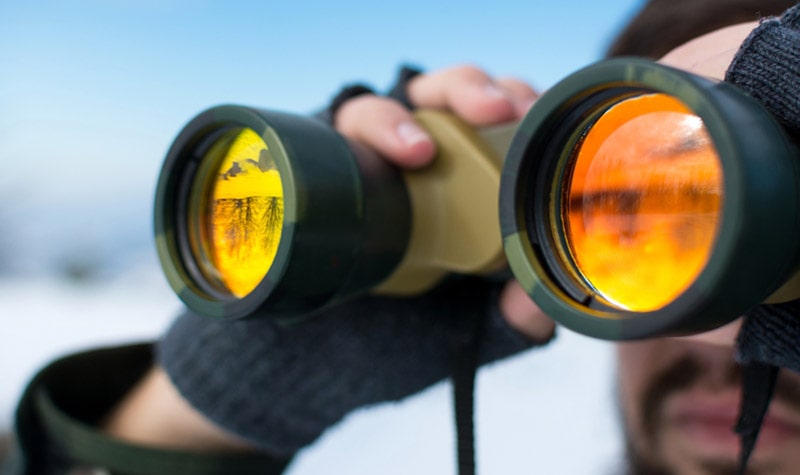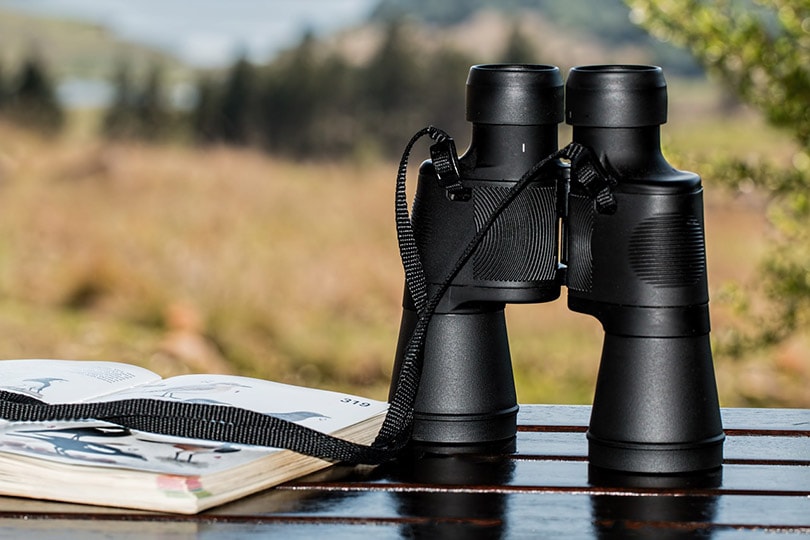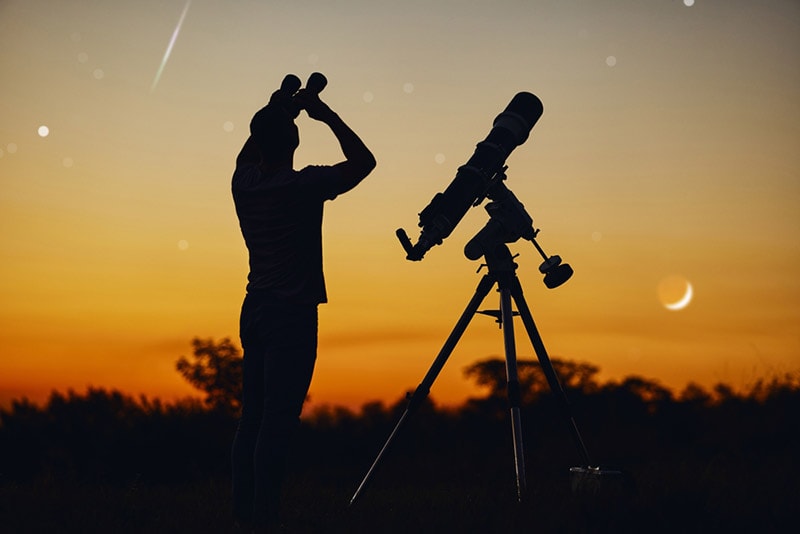Binocular Magnification Chart: Numbers & Distances Compared
Last Updated on

If you’re a hiker, bird watcher, or stargazer, you probably already have a pair of binoculars all packed up and ready for the road. However, while these optical instruments aren’t that hard to use when it comes to the magnification power and lens diameter, things might get a bit confusing. What do all those numbers like 8×32 mean? How do you know which model is right for you?
Don’t worry—we’ve got your back! In this guide, we’ll talk about the ins and outs of binocular strength and size. Next, we’ll cover the best specifications for different hobbies (like bird watching or stargazing) and learn how to pick the best field glasses for your outdoor activities. Let’s get started!

Power & Size: What Do These Specs Stand For?
For binoculars, the two most important parameters to check are the magnification strength and size or, rather, the objective lens diameter. Thus, if you see something like 10×32, that means that the instrument can make the target appear ten times closer. In simpler words, a pair of 10x binoculars will make a bird, rabbit, or elk that’s 1,000 miles away look like it’s just 100 miles away.
With 8x, you will get a wide field of view; 10x offers a more detailed image. As for the lens diameter, it describes the size of the device, with the most popular options being compact, average, and large. Compact binoculars have a <30mm lens size. They’re the most lightweight option on the market. Mid-size models, in turn, are rated at 30–40mm. Finally, the biggest binoculars come equipped with 40mm+ lenses.

How Big Is Big Enough? A Quick Look
To put things into perspective, an 8×42 pair of field glasses will be around 30% heavier and 20% bigger than an 8×32 pair. The difference between an 8×32 and an 8×25 device will be lower, but you’ll still feel it. So, the question is—what are the benefits of a larger lens? Mostly, the lens can capture more light and make the image brighter.
A better color rendition and a more detailed image will be a part of the deal as well. Large lenses do a far better job of capturing details in the shadows, too. That said, if you like to travel light, you might want to go with a smaller pair of binoculars. Full-size binoculars are way too heavy to hold with one hand for a long time. Plus, you’ll have to pay less for a compact model.

What’s the Right Binocular Size for Me?
This greatly depends on what you’re planning on doing with the device. If it’s hiking, 8×25 will be a great place to start. However, for boating, anything lower than 8×42 won’t cut it: the binoculars simply won’t be able to handle the task. So, yes, it all comes down to your specific needs. Our experts put together the following chart to help you pick the right binoculars for each purpose:
Binocular Magnification Chart
| Activity | Magnification Power | Lens Diameter |
| Bird watching | 8x, 10x | 32, 42, 50 |
| Hiking/backpacking | 8x, 10x | 25, 28 |
| Hunting | 7x, 8x, 10x | 40, 42, 50 |
| Whale watching | 8x, 10x | 32, 42 |
| Wildlife viewing | 8x, 10x | 32, 42 |
| Paddling | 7x, 8x, 10x | 32, 42, 50 |
| Sporting Events | 6x, 7x, 8x, 10x, 12x | 25, 28, 32, 42 |
| Concerts | 3x, 4x, 8x | 20, 25, 28 |
| Stargazing | 10x | 42, 50 |
The chart should give you a basic understanding of what type of binoculars to buy for your hobbies. As you can see, in most cases, there are multiple options to choose from. Now, if you want to learn more, read our detailed breakdowns of popular binocular uses and the ideal magnification power and size/lens diameter combos:
1. Bird Watching

For birding, 8×32 and 8×42 binoculars are the best offers on the market. But wait: why not go with a 10x device instead? Won’t it do a better job of magnifying the target? Technically, yes, it will make it look bigger. However, for bird watching, the field of view is more important, and it will be wider with an 8x instrument.
Now, you could go with 8×50, but those binoculars will be significantly heavier. Instead, you’ll be better off investing in weather and impact resistance, along with the anti-fog feature. Otherwise, the binoculars will be damaged by water and dirt, break when bumped, and fog up when you grab them from the backpack.
2. Hiking & Backpacking

When you’re one on one with the Great Outdoors, hiking, camping, and backpacking, every single pound counts. That’s why lightweight binoculars are the best choice here. Compact field glasses will be perfect for this activity. We’re talking about 8x or 10x and a lens diameter of 25 or 28. All these options—8×25/28 or 10×25/28—will be more than enough for a hiking trip.
Again, look for an instrument with a weather-resistant finish. For example, rubber coating is durable, water-resistant, and not at all heavy.
3. Hunting

In most scenarios, a magnification of 7–10x is enough to cover a hunter’s needs. Now, you might be tempted to go for something bigger, but don’t forget about the importance of image clarity/steadiness. For finding tracks, even 7x will be plenty. As for the objective, 40–42 is the “sweet spot”. True, a pair of binoculars with such a large lens won’t be cheap.
But, it will be a reasonable investment in the long run. Oh, and if you mostly hunt early in the morning or late in the evening when there isn’t much sunlight available, a 10×50 pair of field glasses will be more appropriate. Sometimes, 8×32 or even 8×30 could also work, but, for the most part, 8×40 is the safe bet.
4. Wildlife & Whale Watching

Do you prefer safaris, wildlife viewing, and whale watching over hiking, birding, and hunting? Then an 8×32 binocular is probably what you’re opting for. Now, 10×32 is also a great choice, but if you want more precision, we’d recommend an 8×42 or 10×42 pair of binoculars. Planning on watching the wildlife from afar? Then 8×32/42 magnification power won’t always cut it; only 10x will be able to handle the task.
The fans of whale watching should only use 100% waterproof instruments. Otherwise, their binoculars might be ruined by all the water.
5. Paddling

People that like to set sails on a kayak or canoe and watch whales and other marine creatures often use 8x binoculars. You can, of course, try your luck with a 10x model, yet it won’t be easy to get a steady viewing experience with such magnification strength. And what about 7x—will it be a reasonable pick here or not? The short answer is yes, it will be. That device will be lighter and more compact, not to mention cheaper.
Still, for the most part, boating enthusiasts buy 8×32 or 8×42 binoculars. Next, 8×50 is also a possibility; it will be a bit too much for most paddling fans, though.
6. Sporting Events

If you mostly take boat trips and rarely do anything else, you should be able to enjoy a sporting event with your trusty binoculars. That’s because 8×32 and 8×42 are all great choices for having an immersive experience at a football, baseball, or rugby game. The same goes for tennis, derby, and other sports. Speaking of magnification strength, you can even go as low as 7x or 6x for indoor sports.
We’re talking about a theater show. Larger arenas are slightly more challenging and might require 8–10x magnification. And if it’s a full-fledged outdoor spectator sport, 8–12x is the recommended pick. As for the lens diameter, 25 and 28 can be just as great as 32 or 42. It all comes down to the specific sporting event and your personal preferences.
7. Concerts

And what about concerts? What kind of binoculars do you need to fully enjoy a rap/rock/country show? Well, if it’s a stadium show, 7x or 10x will be the perfect magnification. You won’t have a hard time focusing on various targets, and the scaling will be more than enough. That said, if you’re going to a concert hall, 8x, 4x, or even 3x are the preferred choice.
The lens diameter varies as well. To play it safe, go with 20 or 25; 28 works as well. In any case, compact binoculars are the way to go here. They’re cheap, lightweight, easily fit in an average-size backpack, and won’t put extra pressure on your hands.
8. Stargazing

For watching the stars, the bigger the binoculars, the better: anything lower than 10×42 shouldn’t even be on the menu. Instead, you might want to invest in a 10×50 pair of field glasses. True, that purchase won’t be cheap. Furthermore, a 10×50 model will require a tripod to hold it in place. But, if you’re serious about stargazing and want to get the best binoculars for that, do save a bit and get the best option on the table.

FOV vs Lens Size: How Do They Affect the Image?
The first thing that most buyers look at is, of course, the magnification power. After that, they jump straight to the objective lens diameter (the second number in the 8×32 or 10×42 specs). However, the field of view also plays a crucial role. Here’s how it works: the higher the magnification strength, the lower the field of view will be, and vice versa. And a smaller FOV makes the images a bit darker.
That’s because it fails at gathering enough light. As for the diameter, the larger the lens, the more light the device will be able to capture, making the image much brighter and clearer. Summing up, these three parameters (magnification, FOV, and lens diameter) are intertwined, and you can’t focus solely on one feature and expect to get the perfect binoculars for the task at hand.
More Specs to Keep in Mind
Alright, now that we’ve covered all the important specifications, here’s a quick look at some extra parameters to consider:
- Build quality. Most brands put “weather-resistant” in the specs, but these binoculars are NOT 100% waterproof. Light rain is all they’re good for. Waterproof models, in contrast, can survive heavy rain but no water dipping. A rubber coating will protect the device from accidental bumps. Oh, and make sure you get a fog-proof pair of field glasses.
- Prism type. There are two choices here: porro prisms and roof prisms. Porro prisms are heavier and larger, but you’ll get a wider FOV, higher clarity, and overall better image quality. But, if you’re looking for something compact, more durable, and with better magnification, buy a pair of binoculars with a roof prism. That will cost more, though.
- Exit pupil. This parameter is calculated by dividing the diameter by the magnification power. For example, 10×32 binoculars will have an exit pupil of 3.2mm. The lower this number, the darker the image will be. In low-light conditions, aim for 5.25 mm. But if it’s sunny outside, even 2mm will do.
- Eye relief. If you don’t wear any glasses, you can just skip this part. However, if you can’t hit the road without your favorite pair of “goggles”, look for an eye relief of 11mm+. Most modern-day binoculars can be easily adjusted until you find the ideal eye relief, which is a big pro.

Conclusion
Binoculars come in different shapes and sizes, and there are no one-fit-all models: each task/purpose needs a specific pair of field glasses. For example, if you mostly go to sporting events, you’ll need a 6×28 or 8×32 device. Or maybe you like to watch wildlife? Then opt for 8×42 or 10×42. That’s why many pro hunters/watchers have multiple binoculars.
If you’re perplexed by all these specifications, that’s completely normal! You can check out our detailed chart for a quick guide on which instrument to buy for various activities. And once you learn your way around terms like “lens diameter” and “magnification power”, it will be much easier to pick your own binoculars!
See also:
Featured Image Credit: Creative Family, Shutterstock
About the Author Robert Sparks
Robert’s obsession with all things optical started early in life, when his optician father would bring home prototypes for Robert to play with. Nowadays, Robert is dedicated to helping others find the right optics for their needs. His hobbies include astronomy, astrophysics, and model building. Originally from Newark, NJ, he resides in Santa Fe, New Mexico, where the nighttime skies are filled with glittering stars.
Related Articles:
What Is the Best Binocular Magnification for Hunting? Optical Features Explained
When Were Binoculars Invented? History, Today & Future
How to Collimate Binoculars: 9 Expert Tips
Can You Use Binoculars to Look At Stars? How to Choose the Right Pair
How to Choose Binoculars for Bird Watching: 10 Expert Tips
What Does 20X50 Mean on Binoculars? Our Helpful Guide
10 Best Binoculars in Canada of 2024: Reviews & Top Picks
Infrared Binoculars vs. Night Vision: Which Should I Choose?
